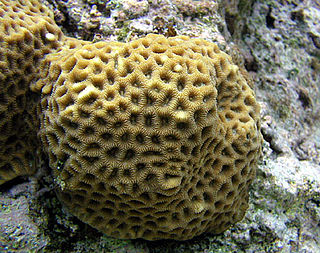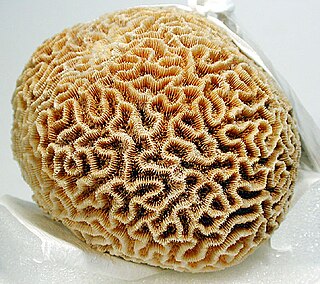Homophyllia bowerbanki is a vulnerable species of coral found in the Pacific and Indian Oceans. This species is moderately common, but it is threatened by crown-of-thorns starfish predation and habitat loss.

Montipora digitata, also known as finger coral, is a species of stony coral. It is found in shallow water in East Africa, the Indo-West Pacific, Kenya, Mozambique and Rodriguez.

Micromussa regularis is a species of coral found in Indo-Pacific waters from Australia to the western Pacific Ocean. It is usually uncommon throughout its range, but can be more common locally. It has a narrow depth range, and so is susceptible to coral bleaching and disease. It is also threatened by the global decline in coral reef habitats.

Acropora muricata, commonly called staghorn coral, is a species of acroporid coral found in the Gulf of Aden, the Red Sea, Indian Ocean, Persian Gulf, Australia, central Indo-Pacific, Japan, Southeast Asia, the East China Sea and the oceanic central and western Pacific Ocean. It is found in tropical shallow reefs, slopes of reefs, and in lagoons, from depths of 5 to 30 m. It was described by Dana in 1846.
Acropora lovelli is a species of acroporid coral found in the northern Indian Ocean, the central Indo-Pacific, Australia and the oceanic west Pacific Ocean. It can also be found in Palau and the southern Mariana Islands, the Red Sea, Mauritius, Tuha'a Pae, the Pitcairn Islands and Rodrigues. It occurs in shallow tropical reefs, in shallow protected lagoons and at lagoon entrances, to depths from 1–10 m.

Acropora microphthalma is a species of acroporid coral found in the Red Sea, the Gulf of Aden, the southwest and northern Indian Ocean, the central Indo-Pacific, Australia, Southeast Asia, Japan, the East China Sea and the oceanic west and central Pacific Ocean. It is also found in the Line Islands. It occurs in shallow tropical reefs on upper reef slopes, in turbid water and in sandy lagoons. It can be found from depths of 5–25 m.

The branch coral is a species of acroporid coral found in the southwest and northern Indian Ocean, the central Indo-Pacific, Australia, Southeast Asia, Japan and the East China Sea, Cook Islands and the oceanic west Pacific Ocean. It can be found in shallow reefs on the reef tops, walls and slopes to depths of 30 m.
Alveopora fenestrata is a species of stony coral that is found in the Red Sea, the Gulf of Aden, the southwest and northern Indian Ocean, the central Indo-Pacific, Australia, Southeast Asia and the oceanic west Pacific Ocean. It can be found in shallow coral reefs, to a depth of 30 metres (100 ft). It is particularly susceptible to coral bleaching.

Alveopora spongiosa is a species of stony coral that is found in the Red Sea, the Gulf of Aden, the southwest and northern Indian Ocean, the central Indo-Pacific, Australia, Southeast Asia Japan, the East China Sea and the oceanic west and central Pacific Ocean. It can be found on protected upper coral reef slopes, generally from depth of 9–20 m, but can grow at depths of up to 50 m. It is moderately susceptible to coral bleaching, and is harvested for the aquarium trade.
Alveopora verrilliana is a species of stony coral that is found in the Red Sea, the Gulf of Aden, the northern Indian Ocean, the central Indo-Pacific, Australia, Southeast Asia, Japan, the East China Sea, the oceanic west and central Pacific Ocean and the Johnston Atoll. It can also be found in Palau and the southern Mariana Islands. It grows on shallow coral reefs to a depth of 30 metres (100 ft). It is particularly susceptible to coral bleaching and is harvested for the aquarium trade.

Montipora aequituberculata is a species of stony coral in the family Acroporidae. It is a common coral in shallow water in the Indo-Pacific region.

Paragoniastrea australensis, also known as the lesser star coral, is a species of stony corals in the family Merulinidae. It occurs in shallow water in the Indo-Pacific region.

Turbinaria stellulata, also known as disc coral, is a species of colonial stony coral in the family Dendrophylliidae. It is native to the Indo-Pacific region. The International Union for Conservation of Nature has rated its conservation status as being "vulnerable".

Turbinaria peltata, commonly known as disc coral, is a species of colonial stony coral in the family Dendrophylliidae. It is native to the Indo-Pacific region. The International Union for Conservation of Nature has rated its conservation status as being "vulnerable".

Favites pentagona is a species of stony coral in the family Merulinidae, sometimes known as larger star coral. It is native to the Indo-Pacific region and its range extends from the Red Sea through the Indian Ocean to the Western Pacific Ocean. This is a common species throughout its wide range and the International Union for Conservation of Nature has rated its conservation status as being of "least concern".

Favites abdita, also known as the larger star coral, is a species of stony coral in the family Merulinidae. It is native to the Indo-Pacific region and its range extends from East Africa and the Red Sea through the Indian Ocean to the Western Pacific Ocean. The International Union for Conservation of Nature has rated its conservation status as being "near-threatened".

Coelastrea aspera is a species of stony coral in the family Merulinidae. It is a colonial species native to the Indo-Pacific region where it occurs in shallow water. It was first described by the American zoologist Addison Emery Verrill in 1866 as Goniastrea aspera but it has since been determined that it should be in a different genus and its scientific name has been changed to Coelastrea aspera. This is a common species throughout much of its wide range and the International Union for Conservation of Nature has rated its conservation status as being of "least concern".

Platygyra daedalea, sometimes known as the lesser valley coral, is a colonial species of stony coral in the family Merulinidae. It occurs on reefs in shallow water in the Indo-Pacific region. It is a common species and the International Union for Conservation of Nature has assessed its conservation status as being of "least concern".

Goniastrea favulus, also known as the lesser star coral, is a species of stony coral in the family Merulinidae. It occurs in shallow water in the Indo-Pacific region. This is an uncommon species of coral and the International Union for Conservation of Nature has rated its conservation status as being "near threatened".

Goniastrea stelligera, commonly known as knob coral, is a species of stony coral in the family Merulinidae. It occurs in shallow water on the coast of East Africa and in the Indo-Pacific region. This is a common species of coral but it seems to be decreasing in abundance. The main threat it faces is from the destruction of its coral reef habitat, and it is also moderately susceptible to coral bleaching, so the International Union for Conservation of Nature has rated its conservation status as being "near threatened".

















